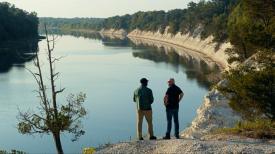人类足迹
人类足迹不仅是我们改变世界的方式,亦是人类与地球之间跨越过去与未来的联系。我们改变世界,世界也反过来改变我们。在尚恩长大的美国南部,一片古老海洋孕育出一种农作物,以及人类为培育它而创造的残酷经济,永久重塑了我们的世界。
这趟旅程从阿拉巴马州伊普斯的白垩岩开始,一片八千万年前隐藏于海床、黑土带的岩石,为美国棉花产业提供肥沃土壤。十九世纪,全球的棉花经济在非裔奴隶的劳动力上建立起来,对美国的土地、文化,甚至美国人的遗传基因产生了深远影响。美国南北战争结束了奴隶制,但棉花的影响通过大迁徒、黑人音乐、文化的传播继续发展,正因这些,白垩纪时代的海滨今天显现为公民行使合法投票权的「蓝色地带」。
棉花的故事正是人类足迹的精髓:在微小化石的基础上,一群人奴役另一群人,为工业提供动力,重塑了地貌、文化和美国人民的基因。人类改变世界、重新定义命运的力量从未如此清晰,正如尚恩在旅途中发现,「人类足迹的这部份结果就是——我」。
双语广播:粤语/英语 (电视版 及 网上版)
播出时间:(首播) 2025年5月12日 星期一 晚上10时
The Human Footprint is more than just the ways in which we transform the world. It’s the connection between humanity and our planet – past and future. We change the world, and the world changes us back. In the American South, where Shane was raised, a primeval ocean allowed one crop – and the cruel economy we crafted to nurture it – to reshape our world forever.
The journey begins at the White Cliffs of Epes, Alabama, where the rocks underneath the Black Belt – the rich soils that supported America’s cotton industry – are laid bare as an 80-million-year-old seafloor. In the 19th century, a global cotton economy was built here on the backs of enslaved Africans, creating profound impacts on America’s land, cultures… and even our DNA. The Civil War ended slavery, but the legacy of cotton continued to grow through the Great Migration and the spread of Black music and culture. Because of that influence, the shores of a Cretaceous sea are revealed today as a “Blue Belt” of citizens exercising their legal right to vote.
The story of cotton is the essence of the Human Footprint: on a foundation of microscopic fossils, one group of people enslaved another to power an industry – reshaping a landscape, a culture, and the very DNA of the American people. The power of humanity to transform the world, and redefine our destinies, has never been more clear. As Shane realizes during his journey, “This part of the Human Footprint… is me.”
Bilingual: Cantonese/ English (TV Version & Web Version)
Time: (First run) 2025.05.12 MON 10:00pm













































